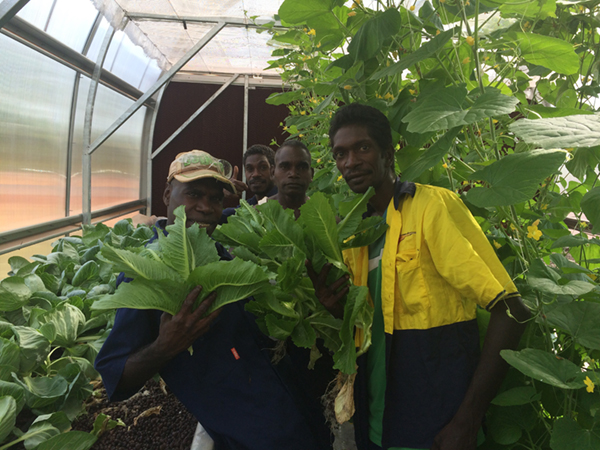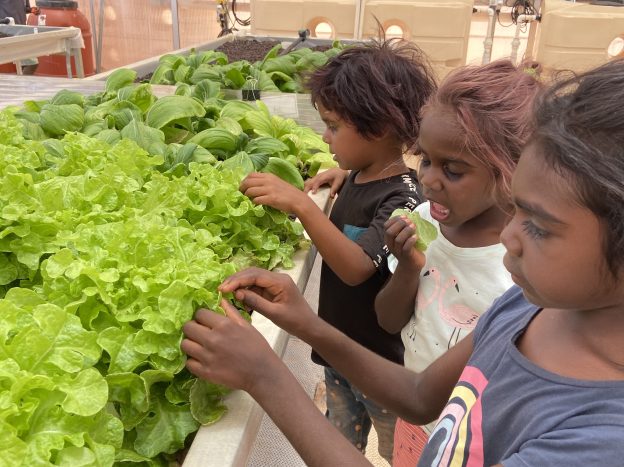Since its inception in 2008, Food Ladder has fed thousands of people and created over 600 jobs for remote Indigenous workers, long-term unemployed people, asylum seekers and public housing tenants. Today, thanks to Third Link funding, Food Ladder is gearing up to exponentially increase its impact.
Food Ladder’s outcomes in food security, wellbeing, education and employment in remote communities
Food Ladder gives people the tools to stop hunger and malnourishment. It provides remote and regional communities with hydroponic greenhouses and specialised training so they can grow fruit and vegetables, and set up their own social enterprise if they choose.
The organisation’s horticulture and business experts offer support throughout the process, leaving behind a sustainable food system, which has health, educational and economic benefits.
Established as a not-for-profit in 2008, Food Ladder has set up local communities to own, manage and run 10 Food Ladder greenhouse systems in:
- Katherine, NT
- Tennant Creek, NT
- Werribee South, VIC
- India – six sites including one stretching across half an acre
- Bhutan
Food Ladder offers five different types of custom-designed agri-tech, including Food Ladder systems that are cyclone-rated. The greenhouses are climate-controlled and thus highly productive, allowing communities to grow just about anything:
leafy greens such as spinach and lettuces
vining crops such as tomatoes and zucchinis
bush foods such as salt bush and native basil
Communities pick a greenhouse that suits their goals and environment. Some want to grow fresh food. Others want to set up a commercial enterprise so they can sell fruit and vegetables and create jobs. Some see it as a community project where everyone can learn about horticulture and nutrition.
Several programs are connected to the greenhouses:
mums and bubs healthy eating workshops
accredited training in horticulture for school leavers
school excursions to the greenhouse to learn about health, nutrition and plant biology
Food Ladder’s horticulturalists give ongoing green thumb tips and training, while their executives have backgrounds in business and offer advice on how to sell produce, access new markets and make a profit. Food Ladder has built 19 successful social enterprises, which have transitioned into self-sustaining businesses.
Third Link funding has helped Food Ladder be poised to scale at just the right time
Third Link funding has allowed an increased sophistication of operations – a much more efficient, leaner setup, perfectly positioned to scale. Food Ladder has established an online platform where growers can get hold of manuals, discounted seeds, advice on sales and supply chain management or seasonal harvest rotation, and much more.
Food Ladder is now at a critical point. Thanks to Third Link funding, the organisation is rolling out 20 new Food Ladder greenhouse systems by the end of 2021 – a 200% increase in just one year.
The Federal Government’s inquiry into food security in remote Indigenous communities helped demonstrate Food Ladder’s unique position as the only scalable, tested and proven solution to food security in remote communities. This has never been more important as the COVID outbreak has severely compromised supply chains in remote areas.
Food Ladder collaborates with all sorts of organisations to get this work done, including not-for-profits, government, and community groups. In what is the first longitudinal study of its kind, Charles Perkins Centre experts at the University of Sydney will benchmark health in a community before a new greenhouse is set up to look at long-term outcomes. Utilising the platform created with Third Link funding, the research is now pulling data in a much more sophisticated way. Food Ladder also awarded a scholarship to an Indigenous student to pursue an MBA at the university.
Working with a top consulting firm, Food Ladder is primed to take the organisation to a whole new level again.
“Without the support of Third Link we simply would not be in the position we are in today – on the cusp of having a truly transformative impact at a national scale.”
Kelly McJannett, CEO, Food Ladder
Impact in communities outperforms original expectations
Food Ladder addresses complex issues from food security, agri-tech and nutrition to education and employment. It’s an end to end solution in remote communities that involves the whole community.
A recently completed case study of Food Ladder’s work in Katherine demonstrates that Food Ladder’s work there has resulted in sustained behavioural change and regional uplift. Purchasing patterns in remote communities are changing as a result, with people across the community choosing fruit and vegetables over unhealthy options, with huge impacts on physical and mental wellbeing, learning outcomes and so much more.

A Food Ladder greenhouse system in Katherine, NT
Many students come to school not ready to learn because of dietary issues that impact on their general health and on their dental health. Food Ladder provides fresh vegetables and fruits to be used in the meals provided by the School Nutrition Program. This gives the long-term benefit of ensuring children have a healthy diet and an understanding about the importance of making good food choices that will have a positive impact on their lives.
“In the last 12 months, the school has placed great emphasis on improving the garden and grounds. This has had a positive impact on the attendance and the calmness of students at the school helping them to be more engaged in their learning. Expanding the Food Ladder initiative will provide more opportunities for the students to work supported by the Yolngu ground staff who act as mentors and instructors to teach the students about looking after the greenhouse equipment and the plants as they grow.
– excerpt from a letter co-signed by Yanaymul Mununggurr (Chairperson) and Katrina Hudson (Principal) in regards to an expansion project at Yirrkala School.
